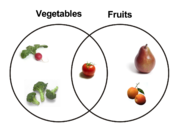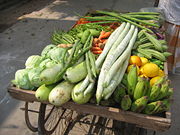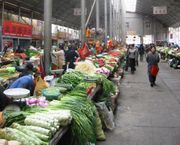Vegetable
2008/9 Schools Wikipedia Selection. Related subjects: Food; Plants

The term "vegetable" generally means the edible parts of plants. The definition of the word is traditional rather than scientific, however. Therefore the usage is somewhat arbitrary and subjective, as it is determined by individual cultural customs of food selection and food preparation.
Generally speaking, a herbaceous plant or plant part which is regularly eaten as unsweetened or salted food by humans is considered to be a vegetable. Mushrooms, though belonging to the biological kingdom Fungi, are also generally considered to be vegetables, at least in the retail industry. Nuts, seeds, grains, herbs, spices and culinary fruits are usually not considered to be vegetables, even though all of them are edible parts of plants.
In general, vegetables are regarded by cooks as being suitable for savory or salted dishes, rather than sweet dishes, although there are many exceptions, such as pumpkin pie.
Some vegetables, such as carrots, bell peppers (or Capsicum as they are known in Australia) and celery, are eaten either raw or cooked; while others, such as potato, are traditionally eaten only when cooked.
Is it a fruit or a vegetable?

The word "vegetable" is a culinary term, not a botanical term. The word "fruit" on the other hand can be a culinary term or a botanical term, and these two usages are quite different.
Botanically speaking, fruits are fleshy reproductive organs of plants, the ripened ovaries containing one or many seeds. Thus, many botanical fruits are not edible at all, and some are actually extremely poisonous. In a culinary sense however, the word "fruit" is only applied to those botanical fruits which are edible, and which are considered to be a sweet or dessert food such as strawberries, peaches, plums, etc.
In contrast to this, a number of edible botanical fruits, including the tomato, the eggplant, and the bell pepper are not considered to be a sweet or dessert food, are not routinely used with sugar, but instead are almost always used as part of a savory dish, and are salted. This is the reason that they are labeled as "vegetables". Thus a plant part may scientifically be referred to as a "fruit", even though it is used in cooking or food preparation as a vegetable.
The question "The tomato: is it a fruit, or is it a vegetable?" found its way into the United States Supreme Court in 1893. The court ruled unanimously in Nix v. Hedden that a tomato is correctly identified as, and thus taxed as, a vegetable, for the purposes of the 1883 Tariff Act on imported produce. The court did acknowledge however that botanically speaking, a tomato is a fruit.
A list of vegetables defined as different parts of plants
- Flower bud: broccoli, cauliflower, globe artichokes
- Seeds: Corn
- Leaves: kale, collard greens, spinach, beet greens, turnip greens, endive
- Leaf sheaths: leeks
- Buds: Brussels sprouts
- Stems of leaves: celery, rhubarb (sometimes called a fruit because sweet pies are made from it)
- Stem of a plant when it is still a young shoot: asparagus
- Underground stem of a plant or tuber: potatoes, Jerusalem artichokes, sweet potato (often incorrectly called a yam in the USA), also the true yam
- Whole immature plants: bean sprouts
- Roots: carrots, parsnips, beets, radishes, turnips
- Bulbs: onions, garlic, shallots
- Fruits in the botanical sense: tomatoes, cucumbers, squash, pumpkins, capsicums (bell peppers and hot peppers), eggplant, tomatillos, christophene, okra, also the following:
Etymology
The word "vegetable" is still sometimes used as an archaic literary term for any plant: vegetable matter, vegetable kingdom. The word comes from the Latin vegetabilis (animated) and from vegetare (enliven), which is derived from vegetus (active), in reference to the process of a plant growing. This in turn derives from the Proto-Indo-European base *weg- or *wog-, which is also the source of the English wake, meaning "become (or stay) alert". The word vegetable was first recorded in print in English in the 14th century. The meaning of "plant grown for food" was not established until the 18th century.
In the diet
Vegetables are eaten in a variety of ways, as part of main meals and as snacks. The nutritional content of vegetables varies considerably, though generally they contain a small proportion of protein and fat, and a relatively high proportion of vitamins, provitamins, dietary minerals, fibre and carbohydrates. Many vegetables also contain phytochemicals which may have antioxidant, antibacterial, antifungal, antiviral and anticarcinogenic properties.
Colour

The green colour of leafy vegetables is due to the presence of the green pigment chlorophyll. Chlorophyll is affected by pH and changes to olive green in acid conditions, and bright green in alkaline conditions. Some of the acids are released in steam during cooking, particularly if cooked without a cover.
The yellow/ orange colors of fruits and vegetables are due to the presence of carotenoids, which are also affected by normal cooking processes or changes in pH.
The red/ blue coloring of some fruits and vegetables (e.g. blackberries and red cabbage) are due to anthocyanins, which are sensitive to changes in pH. When pH is neutral, the pigments are purple, when acidic, red, and when alkaline, blue. These pigments are very water soluble.
Storage
Many root and non-root vegetables that grow underground can be stored through winter in a root cellar or other similarly cool, dark and dry place to prevent mold, greening and sprouting. Care should be taken in understanding the properties and vulnerabilities of the particular roots to be stored. These vegetables can last through to early spring and be nearly as nutritious as when fresh.
During storage, leafy vegetables lose moisture, and the vitamin C in them degrades rapidly. They should be stored for as short a time as possible in a cool place, in a container or plastic bag.
